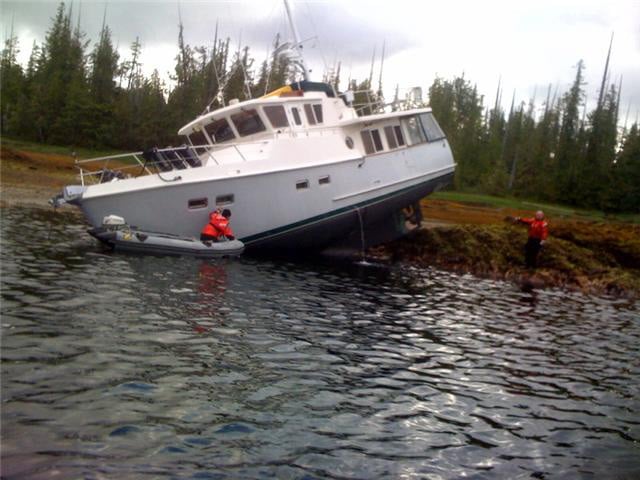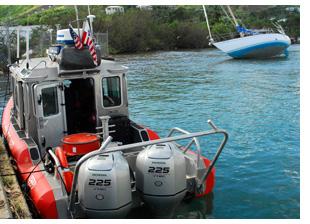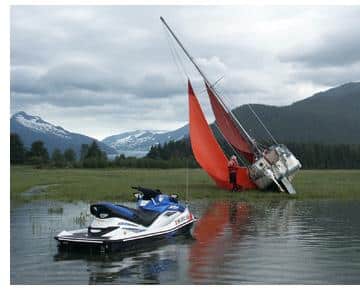
Lindsey’s Law has it that “when your draft exceeds the water’s depth you are most assuredly aground.” In 1772, the captain and crew of the H.M.S. Gaspee, on patrol in Narragansett Bay to enforce a restrictive British trade policy, learned that the hard way. Lured into shallow water by Benjamin Lindsey aboard a small trading vessel, the Hannah, the Gaspee promptly ran aground, was overrun by Rhode Island colonists, and set ablaze in an incident that would prove a precursor to the Revolutionary War.
Boaters today may not have irate colonists to contend with but running aground still happens even in perfect weather, using the latest navigation equipment, and consulting up-to-date local charts. Remember, not all submerged hazards or shallow waters are marked by a danger buoy.
Fortunately, most groundings are more inconvenient and embarrassing than anything else. The key is to know how to respond so that you don’t make a bad situation worse.
The first thing many boaters think to do when they’ve run aground is throw the engine in reverse and give it a lot of power in an attempt to back out of the situation. That may not be the best course of action. You risk damaging your rudder and propeller, or piling up more sand and mud and putting your boat harder aground. If you have holed the hull, moving into deeper water puts you at risk of sinking.
Instead, take a moment to thoroughly assess the situation. If your boat came to a sudden stop, make sure no one on board was injured. That’s your first priority. If you’re not wearing a life jacket, put one on and instruct everyone on board to do the same. Then check to see if you are taking on water. Next, try to determine what type of bottom the boat is sitting on – sand, mud, rocks, coral, etc. – and how hard you’re aground.
If you were traveling slowly and you’ve just touched bottom lightly on sand or mud, another boater may be able to pull you off. You will need to check the wind and current to get the best angle on the pull. Also, be sure to keep all persons far away from the line at both ends. Lines stretch to varying degrees, depending on the type of material, and all can recoil like a slingshot if they snap or pull out a fitting – a very dangerous hazard.

You can also try to free the boat yourself. Turn the motor off and remove the ignition key just to be on the safe side. Lift the outdrive motor and then try to push off with an oar or boat hook. If that doesn’t work, and if it’s safe to do so, you can have someone go over the side and push the boat into deeper water. Depending on the number of people on board, it may be necessary for more than one to get out and push. You might also try shifting the load away from the point of contact, reducing draft by emptying water tanks or moving heavy gear into a dinghy, or pushing the boat from side to side to free it up. If that works, load everyone back in the boat, tilt the motor down just far enough to submerge the propeller, start the motor and proceed at idle speed toward the nearest channel.
If your boat is really stuck, but otherwise seaworthy, it’s often best to simply wait for the next high tide to float it off. This is especially true if you find yourself hard aground on rocks or coral, or where attempting to extricate the boat can result in additional damage to the hull. Floating off with the tide is less stressful to the boat, and to your crew. Be sure to set out a “kedge” anchor as far as possible in the direction of the wind and waves (use a dinghy if you have one). This will keep your boat from being pushed farther aground as the tide rises.
If you’re an unlucky sort and the tide is falling, try to determine how far it will go down and if your boat’s hull needs support and cushioning as it lies over on its side. While you wait for assistance, or the next high tide, do a more thorough inspection of the hull to check for damage.
If worse comes to worse, a commercial towing company can help, although a hard grounding could lead to a costly salvage operation.
Don’t ground your boat…
Ben Franklin may have said it best: An ounce of prevention is worth a pound of cure. In most cases, you can avoid running aground by adhering to the following:
- Keep a proper lookout; this includes watching for shoals and sandbars. Learn to recognize shoal water.
- Check weather and water conditions in advance, but know that most accidents occur on calm, clear days.
- Stay in a marked channel. Aids to Navigation markers are buoys and beacons placed along coastal and navigable waters as guides to mark safe water and hidden dangers. Check your guide to the U.S. Aids to Navigation System, available online at www.uscgboating.org.
- Storms and waves can sometimes move buoys out of place, so be sure to also have, and use, up-to-date nautical charts for the areas in which you plan to operate.
- Check your Fathometer (Depth Finder) and see if it agrees with depths on the charts. Set it to “Shallow-Alarm Alert.”
- Consult your navigation chart; consider a marine GPS to verify your position.
- Be alert to the tides.
- If operating in unfamiliar areas, ask for advice and information from local boaters and marina staff. Take it slow on the water. It gives you more time to orient yourself to your surroundings, and to react.
But if you do…

- Don’t panic. Check if anyone has been injured, and then check for damage to the hull, especially taking on water.
- Determine exactly what you’re aground on – sand, mud, rocks, coral, etc. – and where deeper water might be.
- Check the tide tables to determine the next high tide.
- Don’t attempt to back off without assessing the situation thoroughly. Accelerating in reverse could cause more damage and put you harder aground.
- Try to reduce draft by emptying water tanks, moving heavy gear into a dinghy, or having passengers go over the side to push the boat into deeper water.
- If you’re hard aground, set an anchor toward the wind and waves and as far from the boat as you can – using a dinghy, if you have one – to keep the boat from being pushed farther aground with the rising tide.
- If you’ve sustained serious damage or injuries, contact the U.S. Coast Guard and other boats in the area immediately over the VHS-FM Channel 16 of your marine radio. Depending on the urgency of your situation, make an emergency Mayday call.
- Stay put until help arrives. If necessary, activate your Emergency Position Indicating Radio Beacon (EPIRB), or other emergency signaling devices (flares), if you have them on board.
Even if you don’t need emergency assistance – no serious injuries, minimal damage, etc. – radio the Coast Guard or local marine patrol agency to let them know you’re aground, your position, and what your intentions are. Remember that the Coast Guard will not come to assist or tow unless you are in immediate danger, but they will contact a commercial tower or other individual on your behalf to provide assistance.
The U.S. Coast Guard is asking all boat owners and operators to help reduce fatalities, injuries, property damage, and associated healthcare costs related to recreational boating accidents by taking personal responsibility for their own safety and the safety of their passengers. Essential steps include: wearing a life jacket at all times and requiring passengers to do the same; never boating under the influence (BUI); successfully completing a boating safety course; and getting a Vessel Safety Check (VSC) annually from local U.S. Coast Guard Auxiliary, United States Power Squadrons(r), or your state boating agency’s Vessel Examiners. The U.S. Coast Guard reminds all boaters to “Boat Responsibly!” For more tips on boating safety, visit www.uscgboating.org.








